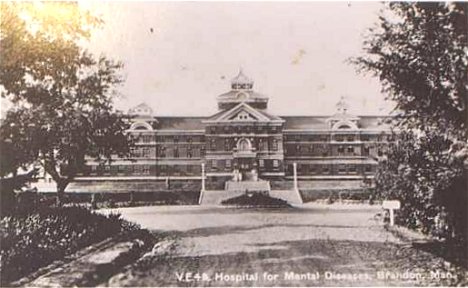
Hospital for Mental Diseases
Introduction
As featured in the book
History of the
Brandon Mental Health Centre
Second Printing Now Available
for purchase :: $20
|
Part of the Bill Hillman Brandon Heritage Website Since 1999 |

Hospital for Mental Diseases
Introduction
As featured in the book
History of the
Brandon Mental Health Centre
Second Printing Now Available
for purchase :: $20
Western society has long grappled with the problem of how to treat or care for persons afflicted with mental maladies. In primitive, and even in relatively advanced societies such as ancient Greece and Rome, mental illness was often associated with the influence of spirits or offended gods and treatment was sought through religion or magic. Care of the afflicted individual was usually based on custom with the burden resting on family or friends. The mentally ill poor were generally left to their own devices, to wander about as social outcasts until such time as they posed a threat to other persons or property. Only those who had the means could afford the medical services of a doctor. Among many ancient physicians, the most recognizable is Hippocrates whose oath has survived for centuries as a guide to ethical behaviour among doctors. With respect to mental illness, Hippocrates has been credited with being one of the earliest medical figures to note the relationship between cycles of elation and depression (characteristic of manic-depressives), which he referred to as mania and melancholia. He also stressed the influence of heredity and predisposition in connection with mental illness. Although often considered the Father of Modern Medicine, Hippocrates was but one of many ancient physicians whose work provided a foundation on which medical science was built.
For centuries, however, much of the knowledge of ancient Greece and Rome was lost to European society. After the fall of the Roman Empire, Europe was plunged into the so called "dark ages." Once again mental illness was associated with spirits and gods. Treatment, likely restricted to a minority of those afflicted, fell primarily into the hands of theologians. It was during this period that the first asylums for the insane appeared in Europe. Although hospitals, such as Bethlem in England, housed a few mental patients before the fifteenth century, it was in 1408 that the first asylum exclusively for the insane was built in Valencia Spain. Subsequently, similar institutions were built in other parts of Europe. These asylums were usually entrusted to monks and priests and treatment was more likely to involve severe chastisement and religious and ceremonial rites than medical care Perhaps the worst manifestation of the mixing of religion and mental illness, however, occurred during the gruesome "witch-hunts" which surfaced periodically from the middle of the fifteenth century until the end of the seventeenth. In view of the fact that queer behaviour was often attributed to witches, it has been argued that large numbers of those burned at the stake or otherwise punished were, in fact, mentally ill persons.
By the eighteenth century, the religious fervour in Europe and Colonial North America had given way somewhat to the rational humanitarian thought attributed to the Age of Enlightenrnent. The mentally ill were no longer persecuted as witches yet their situation was little improved. Although more asylums were beginning to spring up even in the American Colonies, most of the inflicted were cared for by family, left to wander on their own or confined to gaols and poorhouses where the living conditions were wretched. Even those confined to asylums were kept shackled in chains or other mechanical restraint. The treatment of mental illness, which varied from asylum to asylum, consisted of duckings, beatings, chairs which twirled until the patient lost consciousness, bleedings, leechings and the administrations of purgatives and emetics. By the late eighteenth century patients were also being subject to electrical shocks, although this is not to be confused with the twentieth century therapy. Perhaps the most dehumanizing aspect of these institutions was the practice of charging admission for the general public to enter the asylum and view the inmates. To make the show more entertaining, taunting or "baiting" of the caged and chained patients was sometimes allowed. The most notorious asylum of the period was Bethlem in London, whence the term "bedlam" was derived, which remained open to the public until 1770. At the Pennsylvania Hospital in the United States, visitors were paying admission fees at least as late as 1822.
The caging, chaining and exhibiting of mental patients was not without its critics. Late in the eighteenth century there was a significant movement to reform the treatment of the insane. Three names in particular, Philippe Pinel in France, the Tuke family in England and Benjamin Rush in America are synonymous with improving the care for the insane. Pinel, who worked at several hospitals in France, made daily rounds and recorded his own observations and took notes of conversations which he had with patients in an effort to understand the nature and cause of their illness. This approach caused him to be viewed as a pioneer in the use of psychotherapy. In addition to his intimate contact with patients, Pinel advocated work, recreation, and stern kindness towards patients as part of a "moral treatment" ("moral" being roughly equated with psychological), approach to mental illness. Finally, Pinel has been glorified as the first physician to free the patients from their shackles. He, among other practitioners of the time, felt that mechanical restraint should only be used as a last resort. A similar regime of care was advocated by William Tuke at the York Retreat founded in England in 1792 with Quaker assistance. Along with removing mechanical restraint whenever possible, Tuke emphasized humanitarian treament of the patients, as well as farm work, recreation, exercise, ample food and an atmosphere of religious sentiment in keeping with the Quaker foundations of the Retreat. Across the Atlantic, Benjamin Rush, a more controversial figure, was carving out his own niche. A signatory of the Declaration of Independence and physician at the Pennsylvania Hospital for thirty years, Rush was an energetic and influential advocate for reform in the treatment of the insane. His clinical and theoretical work helped put the study of mental illness on a more scientific plane and despite criticisms about his use of bloodletting and purgatives, he has been heralded as the father of American psychiatry.
Despite the reforms taking place into the nineteenth century on both sides of the Atlantic, many of the mentally ill remained in prisons, workhouses, with family or left to their own devices. In North America, including Canada, the work of one reformer, Dorthea Lynde Dix, went a long way to change this. For many years Dix scoured the prisons and almshouses of America gathering information on the deplorable conditions mental patients were being subjected to. Time and again she forcefully presented her case to legislative bodies and she has been credited with playing an instrumental role in the creation of at least thirty state mental hospitals. The drive to reform started by Dorthea Dix gained momentum and fueled a mid-19th century era of asylum building in North America. Unfortunately, along the way something went awry. Small institutions gave way to increasingly larger state asylums built and organized according to the "Kirkbridge plan." The plan called for a central administration structure from which projected wings to house the patients. Originally, a maximum of 250 patients per institution was intended in the plan, but it was easy, and economical to build larger and larger structures housing many hundreds or even several thousand patients. Such state run institutions usually had only a small number of physicians who were so involved in administrative duties they had little time to see patients on a regular basis. Thus the economy and convenience of housing vast numbers of patients under essentially one roof precluded the effective treatment of individual illnesses and the "custodial" asylum was fully evolved by the third quarter of the nineteenth century.
Although Canada lagged well behind the United States in terms of immigration and population, a similar pattern of mental asylum development occurred, only at a later date. Outside of Quebec, where mental patients had been housed at the Hotel Dieu in Quebec City since the seventeenth century, the first asylum for the insane in British North America was built in St. John, New Brunswick in the 1830's. In Ontario, the insane were housed in county gaols until 1841 when a temporary asylum was built in an abandoned gaol in Toronto. Following an influx of Irish immigrants during the potato famine of the late 1840's, there was need of further facilities for the insane and a permanent asylum was opened in Toronto in 1850. Within the next twenty years, asylums were opened in Kingston, Orillia, Fort Maiden near Amherstberg and London. While the Orillia and Fort Maiden asylums were closed down when the London Asylum opened in 1870, the pressing need ; for more asylum facilities prompted the construction of an asylum in Hamilton in 1875, a second branch of the Toronto Asylum in Mimico in 1894 and the Brockville Asylum, also in 1894. This flurry of construction was indicative of the fact that existing facilities soon became overcrowded, assumed a custodial nature and necessitated the building of more asylums. A similar pattern was to be repeated in western Canada.
Prior to Manitoba becoming a province in 1870. there were no special provisions for the insane while the territory was under Hudson's Bay Company Rule. The insane either wandered at will, were looked after by friends or, if they were native, were either cared for or disposed of in some traditional manner. With the establishment of a temporary penitentiary at Lower Fort Garry in 1871. the province applied successfully to the federal government for permission to house any dangerous lunatics in the temporary prison. From 1871 until the completion of a permanent penitentiary at Stony Mountain in 1877, the insane in Manitoba were housed in Lower Fort Garry. Subsequently all those in custody were transferred with the criminals to Stony Mountain. As there were seldom more than a half dozen dangerous lunatics in custody, housing them with the prisoners posed only minor inconveniences, such as sleepless nights for the convicts. However, with the passage of an order-in-council which stated that all lunatics, dangerous or not, be admitted and held in a separate portion of the building apart from the criminals the number of insane in Stony Mountain began to rise. By 1883 it was recognized that a separate facility for the province's insane was needed.
In 1884 the Dominion Government ordered the provincial authorities to remove the insane from Stony Mountain with all haste despite the fact that an asylum being built at Selkirk was not yet near completion. Once again Manitoba's insane would be housed in temporary facilities at Lower Fort Garry and in February, 1885, 35 patients were transferred there from Stony Mountain. This time, instead of being under the eye of a warden, the patients were entrusted to the care of Dr. David Young. A graduate of Queens University, Young had been appointed on Jun 1, 1884 as the first medical superintendent in Manitoba. Also in June of that year, the cornerstone of the Selkirk Asylum had been laid and construction started. The building was finally ready for occupation in May, 1886 and on the 25th, the patients, who had spent over a year at Lower Fort Garry were transferred to a permanent asylum for the insane. Although only 59 patients were in the first transfer, and the opening capacity of the Selkirk Asylum was 167, overcrowding soon ensued. In 1888, more that 20 patients that were the responsibility of the Dominion Government had to be be transferred to Stony Mountain. Within two years, to relieve further congestion a number of patients were transferred to the newly opened Portage Home for the Incurables. The pattern of overcrowding was thus emerging on the prairies as it had elsewhere. Such was the situation in Manitoba in 1890 on the eve of the opening of the Brandon Asylum.
(The information for this introduction was derived from works by
T.J.W. Burgess, Albert Deutsch, Cheryl L. Krasnick and Jerome M. Schneck.)
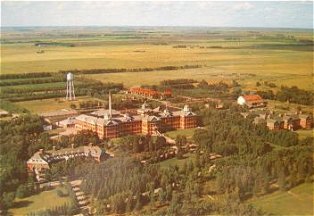
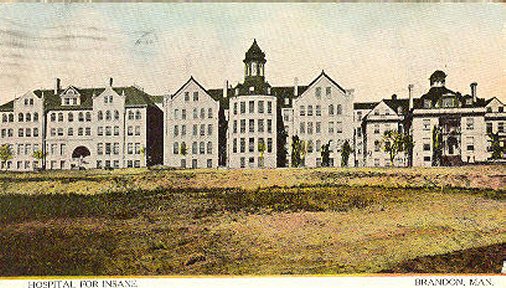
Hospital for the Insane
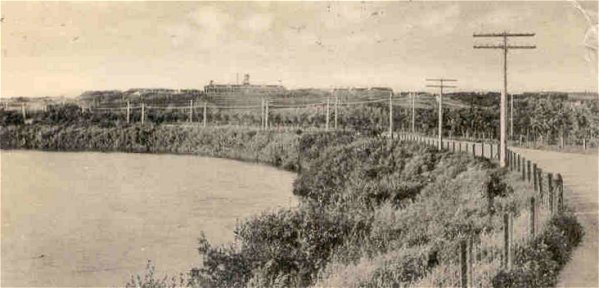
Assiniboine River and Brandon Mental Hospital on 1st
Street
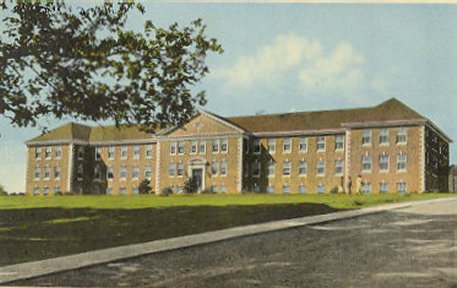
Brandon Mental Hospital 1940


Hospital for Mental Diseases
![]()
BMHC WEB TOUR DIRECTORY
Please Note: The Museum is temporarily closed. Actual tours are
no longer offered at this time.
www.hillmanweb.com/bmhc
|
www.hillmanweb.com |